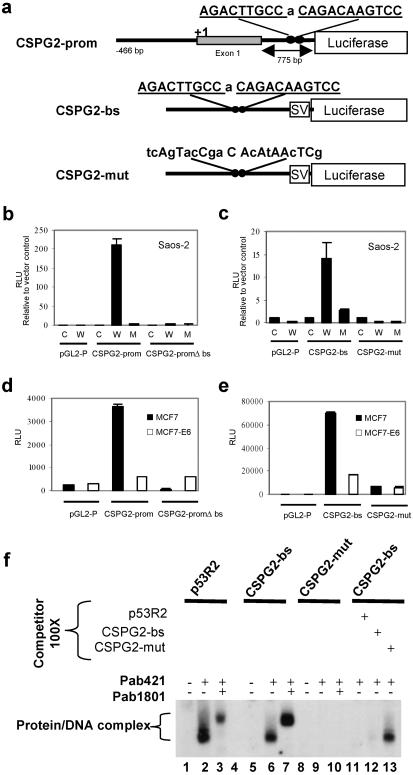Fig 2.
CSPG2 contains a functional p53 bs. (a) Schematic representation of the reporter gene constructs used. The two decamers that constitute the identified p53 bs in CSPG2 intron 1 are underlined. SV, minimal promoter. (b) Activation of the CSPG2-prom construct by wt, but not mutant, p53. pGL2-P, CSPG2-prom, or CSPG2-promΔbs were cotransfected, along with a construct encoding wt p53 (W), mutant p53–248W (M), or pCMV empty expression vector (C) in Saos-2 cells. (c) Saos-2 cells were cotransfected with CSPG2-bs, CSPG2-mut, or pGL2-P empty vector, and W, M, or C. wt, but not mutant, p53 activates transcription of a heterologous promoter in the presence of the CSPG2 p53 bs. Mutations in the CSPG2 p53 bs abolish this activation. (d and e) MCF7 and MCF7-E6 cells were transfected with the constructs in a. When CSPG2-prom was transfected into MCF7-E6 cells (p53 null), no increase in the luciferase activity was observed. In contrast, transfection of this construct into MCF7 cells showed a marked increase in luciferase activity. Similar results were observed when transfecting CSPG2-bs. For b–e, luciferase activity is shown as relative light units (RLU), and for Saos2 cells it is shown as fold induction relative to the activity of the reporter vector in the absence of p53. (f) EMSA was done by using radiolabeled CSPG2-bs, CSPG2-mut, and p53R2 oligonucleotides with nuclear extracts from p53 +/+ cells treated with 500 μM etoposide.

